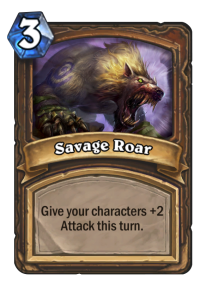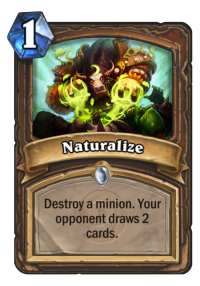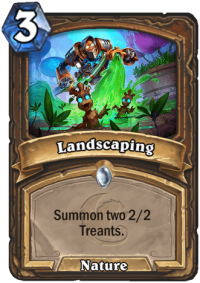The avalanche of changes brought along with the Standard rotation, the two KnC nerfs and the Hall of Fame decisions give Team 5 a unique opportunity to establish their new vision for Hearthstone. With The Year of the Dragon’s first release marking the first time they’ll push out a set created in its entirety after the departure of Ben Brode and his lieutenants, it is guaranteed to change the lay of the land in more ways than one – and perhaps the most interesting question is what they intend to do with Druid, a class they’ve systematically torn down over the course of the last few months.
For the Wilds
It’s no secret that Druid is no longer the powerhouse it used to be. With gutted ramp tools, vastly diminished post-rotation combo potential and limited support for token-based strategies, the class is going to require a completely new identity going forward. While most newer players remember it for its incredibly strong shell created off the back of the Knights of the Frozen Throne class cards, the ramp capability itself was effective enough that Druid’s Classic set itself carried it all the way until Whispers of the Old Gods and the nerf to Force of Nature – back then, the summoned Treants had Charge but died at the end of the turn, giving a 14-damage-from-hand two-card combo on tap which was good by itself to keep the class afloat in every single metagame. Consequently, Druid’s class cards from the later expansions were mostly awful, exploring odd side-synergies which were dead on arrival simply because their toolkit was already good enough.

A combination of nerfs and Hall of Fame rotations now destroyed all these tools. Obviously, the old combo has not been in the game for over three years now, but now Druid seems to have lost everything with the nerfs to Wild Growth and Nourish, the rotation of its Standard “shell” and Naturalize’s move to the Hall of Fame.
Not all of these changes are made equal. Once again, the ramp changes feel like a knee-jerk reaction to a problem enabled by specific cards in Standard. There is nothing wrong with a 2-mana Wild Growth by itself (apart from perhaps the fact that it invalidates many other options for the class in that cost slot, something which isn’t fixed by its nerf because a ramp-oriented strategy won’t be packing such cards anyway): the downside of mana acceleration is a reduced hand size. The real concern is that this has not really come in to play in the recent Standard rotation due to Ultimate Infestation: it doesn’t matter how many cards you give up in the process of mana acceleration if you know you’ve got a five-card reload with initiative waiting at the end of the road.
Similarly, while Naturalize’s move to the Hall of Fame definitely makes sense in the context of the current strategies and class identity – and strong Arena players have long ago identified the card’s strength even in a limited format –, the justification given for its departure (it gives the class “a powerful option in matchups where card advantage doesn’t matter”) once again points to the specific archetypes made viable by the current rotations, especially the tools given in Knights of the Frozen Throne and KnC.
Incredible stall options in the form of Malfurion the Pestilent, Spreading Plague, UI itself and Branching Paths, not to mention the hyper-efficient removal option of Lesser Jasper Spellstone alongside the usual suspects formed a strong enough shell to enable three or four different archetypes by themselves, all revolving around playing the waiting game before nuking the opponent in one go – either literally with Malygos, figuratively with King Togwaggle or spiritually with Hadronox.

It’s the combination of these two elements – insane stall plus instant finishers – that made Naturalize from a red-headed stepchild of removal spells into a hyper-efficient option. It almost never saw play in the old midrange Druid decks or the Yogg Druid archetype popularized at the beginning of the Year of the Kraken. This essentially means that the card was an irrelevance for most of Hearthstone’s existence but a recent swath of strong class cards that are going to rotate out anyway – partly propelled by other Classic tools which were already nerfed to the ground to begin with – condemned it to Wild.
The flipside of this argument is that Naturalize is either irrelevant – and it won’t be missed from the Standard toolkit – or the enabler of hyper-powerful strategies, making this a relatively harmless rotation to the Hall of Fame. It also makes a lot of sense from a flavour standpoint as well: hard removal was indeed Druid’s Achilles heel (alongside swarms of fragile minions), and it was clearly designed as a tool with a prohibitive downside so that every class has at least a nominal tool of its kind in Classic. Then again, this sort of balance has also been gone for a while.
Green New Deal
So where can Druid go from here? Flavor-wise, Team 5 has tried for a long time to infuse the class with Beast synergies (having little to no success apart from a tier two deck during One Night in Karazhan after years of trying) and they’ve also somewhat encroached on Warrior territory with Taunt and Armor-related cards. Clearly, the synergistic elements of the latter were not necessary as long as the cards otherwise reached a critical mass to enable pure stalling strategies – meaning these options are likely off the table.
What else has Malfurion done in the past? Token-ish strategies trying to finish the game off with Savage Roar. Options to buff wide boards were always around, even if these archetypes often took a backseat to other Druid builds. They were also one of the classes given specific C'Thun-related tools and the ultimate Jade card as well. Big minions (and a corresponding ramp strategy) was also pushed a bit with Jungle Giants, Earthen Scales, Giant Anaconda and Tortollan Forager in Journey to Un’goro – however, ramp decks like these always seem to do better with an unfair combo strategy in mind than simply by trying to push out massive minions as quickly as possible. Then again, ramping options still remain in Standard, even if the evergreen cards were nuked. Biology Project, Floop's Glorious Gloop and Dreampetal Florist can still provide such options going forward in appropriate metagames.
There are two new directions Team 5 seems to be gearing up Druid for, and their slow introduction over the last two sets begins to make more sense once you consider that they may have had the nerfs in mind for a long while. Treant-based synergies are a flavorful way to establish a new token-y archetype, but the synergy has to be built from the ground up: only eleven class cards ever printed feature such things, and a mere three of those are from the evergreen set (Soul of the Forest, Force of Nature and Cenarius).

Additionally, Rastakhan’s Rumble began to establish a Druid archetype revolving around its hero power – this seems like the less promising avenue of the two. Despite the (slightly concerning) OTK potential with Gonk, the Raptor, the fact remains that rewarding the player for using their hero power has been a spectacular failure with Inspire and a strategy like this only seems viable for aggressive decks – meaning “hero power Druid” decks will have to walk a very narrow tightrope between woeful underpoweredness and frustratingly fast killing potential.
Of course, there’s nothing to stop Team 5 from trying yet another new thing with the class – certain ideas like Freeze Shaman were introduced and then immediately discarded, meaning it’s quite possible that they can free up enough class cards in the first release of the Year of the Dragon to introduce yet another option. What seems certain is that every previously existing approach and archetype will be thoroughly gutted by the combination of nerfs and rotations, and therefore much manual work will be required to re-establish any sort of a coherent Druid identity.

[…] Article: Why The Year of the Dragon’s Druid is a Blank Canvas […]
Sending Naturalize to HoF because it doesn’t fit the class identity rings a little hollow when they nerf the quintessentially Druid thing of being able to ramp into big monsters.
If they were worried about class identity they’d never have given Druid strong or cheap stall options (Spreading Plague, Crypt Lord), massive armour gain (Druid’s always had some, but never so much, nor as flexible) or Ultimate Infestation.
Even the Innervate nerf could have been handled in a more “Druidy” way; if they had made it something more like Preparation for Minions (e.g. “The next minion you summon costs 2 less”), that would have fit the class identity far more while nerfing the (possibly problematic) Malygos / Auctioneer builds at the same time.
They broke Druid’s class identity a long time ago – they’re going to have to start from scratch this standard rotation.
Found this article a little while ago – pretty much sums it up IMO: https://www.gamecrate.com/hearthstone%E2%80%99s-identity-crisis/21473
Good article as always. What is the “OTK Potential” with Gonk?
Duplicate Gonk, buff your attack, kill multiple enemies. Each enemy killed adds a a pair of extra attacks, so you can have enough extra attacks to OTK.
I am so sad about druid at the moment, the class is unplayable and after the rotation I hope it gets some good cards from the new expansion. Same goes for shaman
Hope that too, especially for shaman.
What does KnC (nerfs) stand for?
KnC is short for the Kobolds and Catacombs expansion.
Innervate and spreading plague got nerfed